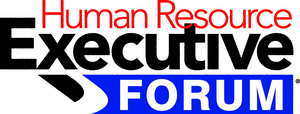Recently in NYC and at the end of one conference, I was granted a press pass into the HR Week ‘Human Resource Executive Forum‘. Many thanks to Eric Winegardner from Monster and Rebecca McKenna from Human Resource Executive Magazine for helping me get there. I’m always amazed when you go to a “real conference” vs. an “un-conference”. The vibe at the real conference is so formal. I was greeted by the very efficient team of people at registration and soon, badge and information in hand, I was rushing down the hall to catch a session.
One I was able to attend was “Workforce Planning and Analytics: New Face of Planning” which was led by Dr. Jac Fitz-enz. He is a leading authority who specializes in measuring human capital. You can learn more about him here.
I quickly got settled in the back of the room, next to Eric Winegardner, and we fired up our netbooks to take notes. I wanted to tweet during the sessions but earlier I noticed that there was no wifi available to participants UNLESS I WANTED TO PAY $100!!! WHAT?? Anyway, we were just getting ready to take notes when something shocking happened. Dr. Fitz-enz introduced himself and one of the first things he did was ask participants not to text or use their computers. I’m stitting there thinking, how on earth am I supposed to cover this session as “press” without being able to take notes? This attitude is completely behind the times. I will suggest that conferences going forward should make sure to offer wifi to all participants and should certainly allow netbooks or pcs to be able to take notes to bring back to the organizations. That said though, I really enjoyed the session and learned quite a bit.
Words matter
Although the session was called workforce planning, Dr. Fitz-enz wanted us to understand that words drive attention and action. So by using the phrase “capability planning” rather then workforce planning, you will be creating a mindset that is receptive to thinking in terms of the capabilities that individual employees bring to your workforce.
What human capital is about
According to Dr. Fitz-enz, human capital planning is not about, “filling jobs or putting butts in chairs.” It’s about looking at how capable your workforce is and how that affects your organization’s mission. How capable are the incumbents? If you’re not considering the skills of the people waiting in the wings, you may lose them. You have to keep them challenged and progressing. Human capital is about managing the risk of losing your great players. You need to find employees that can anticipate what you’ll need them to do A YEAR FROM NOW, not someone who is able to do what they did for you last year. Dr. Fitz-enz says, “when you have about 75% of your mission critical positions with someone ready to step in tomorrow, you begin to see revenue per employee increase. Until that point, it’s flat, and research bears this out.”
What about planning analytics?
Planning analytics is about applying logic, accounting, statistics, and data mining to analyze current and historical data to make predictions. But, what if people were your brand? Whenever knowledge is your product, it is much harder to apply metrics and measures. Even so, you have to find ways to tie performance to business measures so that you can predict. In addition, Dr. Fitz-enz believes that in the future, HR professionals will need to focus on the future instead of looking at the benchmarks of the past. You have to look at what is going on in the environment both internally and externally in the marketplace. Only then will you be able to plan and get all departments integrated and focused on the organization’s vision.
On processes and effectiveness
One critical component of effective workforce planning is how well you organize your workforce. Is the facility they work in configured properly to maximize efficiency? What steps can you take to improve productivity relative to the way in which people are working? You’ll also need to take a hard look at your organization’s processes before you just decide to make and upgrade and throw technology at it. That is not what will drive effectiveness. Careful analysis of current processes will help guide what type of technology makes the most sense. This should be done after you’ve taken time to examine each process.
Engagement is not correlated with productivity
This was something that came up in two sessions and really caught the attention of the audience both times. I think it’s because as HR professionals, we are constantly told that if you have a high level of employee engagement, you will see productivity increase. It just makes sense. I think the clarifying point that Dr. Fitz-enz made is that while that may be true in most cases, there is not a mathematical correlation. So, if the engagement scores increase by 2%, you will not see a 2% increase in productivity. Related, not correlated.
Where I disagree with Dr. Fitz-enz
Whenever you hear an industry expert speak, you are most likely going to be hard pressed to find flaws. Not that I was looking for them, but one thing he said I whole-heartedly disagree with. He said, “Leadership is a finite thing. There is only so much that can be said about it.” In my notes that day, I actually followed that sentence up with an expletive. Very unusual for me to do that. It just struck me as an odd thing to say for such a progressive thinker. I think the only way we’ve heard enough on leadership is when we are at the point where a “right” way of leading has been established. I do not ever think we’ll be at that point. As long as there are people leading companies, there will need to be many types of leadership styles to put toward making the organization a success. Therefore, the discussion of what makes good, solid leadership will continue.
Thanks again to Rebecca McKenna for giving me the opportunity to experience part of the Human Resources Executive Forum at HR Week. I encourage you to mark your calendar now for next year’s event.




3 Comments
Great post, Trish… thanks for sharing.
Sounds like it was an interesting session (minus the $100 WiFi) and some points do resonate. I spent a good chunk of my career in the manufacturing technology space before becoming completely fascinated by HR technology and there are definitely some “best practices” that can be shared.
For example, the comments on organization and productivity represent a classic “lean” manufacturing concept. Also, the recommendation of analyzing processes “before throwing technology at a problem” sounds a lot like a Six Sigma approach (Define – Measure – Analyze – Improve – Control) and is sound advice.
However, I also agree with your assessment regarding leadership styles and there not being a single “right” way to run a team or a company. I’ve worked for organizations that were engineering-oriented, marketing-oriented and everything in between. Each type of organization presents equal parts opportunity and obstacle, but the effective leader finds a way to leverage the strengths of the company (and the individuals who comprise the workforce) and use it to their advantage.
I haven’t been to HR Week in a couple of years but I plan on attending the next one.
Thanks for the post, Trish. Look forward to seeing you at HRevolution!
– Marc
Thanks Trish for joining us in New York and your kind comments.
This was the first year that we held the HR Executive Forum during HRWeek and it was a great success. The content was excellent and those who attended, networked and shared their knowledge were terrific.
I’ll let you know dates and times for next years event as soon as we finalize.
Best Regards,
Rebecca